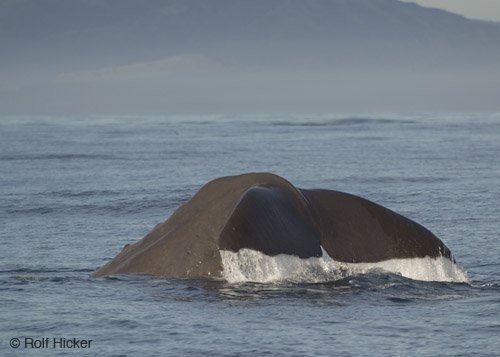Sperm Whale Facts Information
Facts, information and pictures for Sperm Whales.
Path: Animal Facts / Sperm Whale Facts & Information
-
Sperm Whales
- Scientific Name: Physeter macrocephalus
- Family: Toothed Whale
- Class: Marine Mammal
Sperm Whale Facts: GENERAL Information:
The Sperm Whales (please check out our sperm whale pictures)is the largest of the toothed whales and is the largest toothed animal in the world. The whale was named after the milky-white substance spermaceti found in its head and originally mistaken for sperm. The Sperm Whale's enormous head and distinctive shape, have led many to describe it as the archetypal whale.
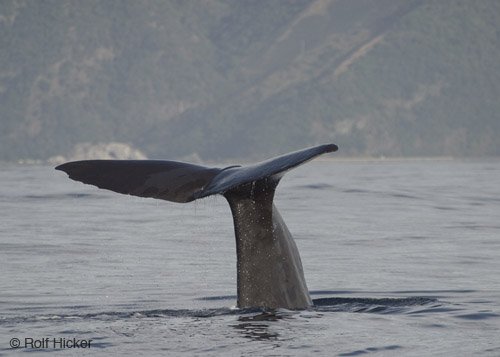
Large Sperm Whale lifting fluke up for a long dive off the Kaikoura coast on the South Island of New Zealand
Sperm Whale Facts: PHYSICAL CHARACTERISTICS:
The Sperm Whale is exceptional for its very large head, particularly in males, which is typically one-third of its length. In contrast to the smooth skin of most other large whales, the skin on the back of the Sperm Whale is usually knobbly and has been likened to a prune by whale-watching enthusiasts and is uniformly grey in colour. The brain of the Sperm Whale is the largest and heaviest of all animals (weighing on average 7 kg in a grown male). However, the brain is not large relative to body size.
Sperm Whales breath air at the surface of the water through a single, s-shaped blowhole. The blowhole is located on the left side of the front if its huge head. They spout (breathe) 3-5 times per minute at rest, but the rate increases to 6-7 times per minute after a dive. The blow is a noisy, single stream that rises up to 50 feet (15 m) above the surface of the water and points forward and to the left of the whale at a 45° angle.
The dorsal fin is set about two-thirds of the way down the spine and is typically short and shaped like an equilateral triangle. The fluke is also triangular and very thick. Flukes are lifted very high out of the water before a whale begins a deep dive.
Sperm Whales have 20-26 pairs of cone-shaped teeth in their lower jaw. Each tooth can weigh as much as one kilogram. The reason for the existence of the teeth is not known for certain. It is believed that they are not necessary for feeding on squid. The current scientific consensus is that the teeth may be used for aggression between males of the same species.
The Sperm Whale has several adaptations to cope with drastic changes in pressure when diving. The ribcage is flexible to allow lung collapse, and the heart rate can decrease to preserve oxygen supplies. Blood can be directed towards the brain and other essential organs only when oxygen levels deplete. The spermaceti organ may also play a role.
Between dives the Sperm Whale will come up to the surface for breath and remain more or less still for eight to ten minutes before diving again.
Males are typically 30-50% longer (16-18m) than females (12-14m) and weigh about twice as much (50,000kg vs 25,000kg). At birth both males and females are about 4m in length and 1,000kg in weight.
Females give birth once every four to six years and the gestation period is at least 12 months and possibly as long as 18 months with the calf being born tail first near the surface of the water. The newborn instinctively swims to the surface within 10 seconds for its first breath; it is helped by its mother. Within 30 minutes of its birth the baby whale can swim. The newborn calf is about 13 feet (4 m) long and weighs about 1 ton (0.9 tonnes). Nursing takes place for two to three years. In males puberty lasts for about ten years between the ages of about 10 and 20. Males continue to grow into their 30s and 40s and only reach their full size when about 50 years old.
Sperm Whales live for up to 80 years.
Sperm Whale Facts: DIET:
Sperm Whales are one of the deepest-diving mammals in the world. They are believed to be able to dive up to 3000 metres in depth and 2 hours in duration to the ocean floor. More typical dives are around 400 metres in depth and 30-45 minutes' duration. They feed on several species, in particular giant squid, octopuses, and demersal rays. The white scars often seen on the bodies of Sperm Whales are believed to be caused by squid. Sperm Whales are prodigious feeders and eat around 3% of their body weight per day.
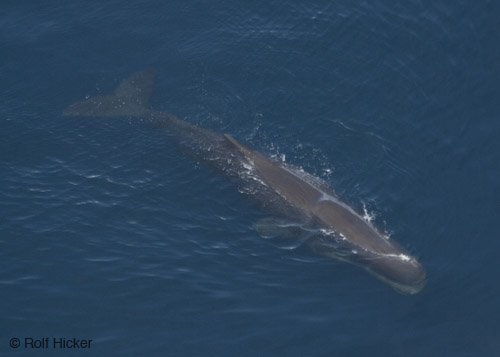
Aerial picture of a large Sperm Whale in the deep Pacific Ocean off Kaikoura, South Island of New Zealand
Sperm Whale Facts: SOCIAL STRUCTURE:
The social structure of the Sperm Whales species divides on sexual lines. Females are extremely social animals. Females stay in groups or pods of about a dozen individuals and their young. The members of a pod protect the young, the sick and the injured. This group structure allows a mother to dive very deeply to hunt while leaving her young calf, who is unable to dive very deeply, at the surface and protected by the pod.
Males leave these 'nursery schools' at somewhere between 4 and 21 years of age and join a 'bachelor school' with other males of a similar age and size. As males grow older they tend to disperse into smaller groups and the oldest males typically live solitary lives.
Sperm Whale Facts: COMMUNICATION
Sperm whales use echolocation to catch their prey in the dark oceanic depths. Mothers also use it it keep track of their young calf when they are diving to hunt; a calf cannot dive very deeply because it has to breathe much more frequently than the mother does.
- facts about Killer Whales (Orcas)
- facts about Humpback Whales
- facts about Gray Whales
- facts about White Sides Dolphins
- facts about Sea Lions
Other facts about whales

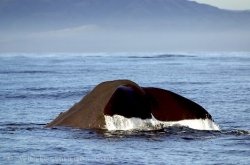
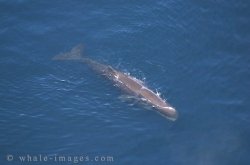
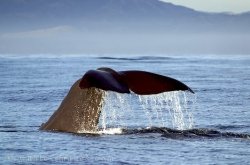
Keywords
- page
- Animal Facts (9)

